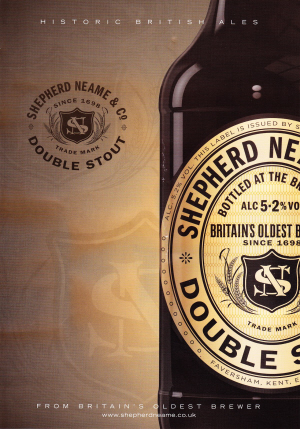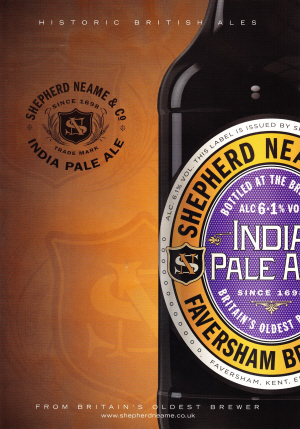
Shepherd Neame Double Stout
Top Tastings 2012 (India Pale Ale)
ABV: 5.2% and 6.1%
Origin: Faversham, Kent, England
Website: www.shepherd-neame.co.uk
When I was rediscovering beer back in the mid-1990s, one of my favourites was bottle conditioned Shepherd Neame Spitfire, regularly available in my local supermarket. Its classic combination of rich malts and moist, sacky and earthy English hops struck me as just what a proper beer from one of Britain’s most important historic hop growing regions should taste like.
The brewery, right in the middle of the pretty little town of Faversham in marshy country by the Swale, even has hop cones picked out in plaster pargeting on the brewery walls, and back then its beers were widely admired. But over the years since, its range seemed to have got blander and more conservative. Cask Spitfire became a less distinctive national brand, supported by World War II-inspired adverts in dubious taste, while the bottled version was unsympathetically pasteurised into a lifeless boiled sweet beer.
Sheps drew further criticism from connoisseurs for its insistence on using clear glass bottles, even claiming that some customers preferred the resulting light struck ‘skunked’ quality. It had seemingly become more interested in its roster of generally indifferent international lager brands brewed under license – Asahi, Hürlimann, Kingfisher, Oranjeboom, and recently Samuel Adams – than in ensuring the distinctiveness of its ales.
But recently there are signs that things are in Faversham are looking up. A new head brewer, Richard Frost, joined from Marston’s late in 2011. Generation Ale, a big dark barley wine that, while certainly ambitious and distinctive, didn’t quite cohere enough to justify its strength or price, appeared shortly afterwards. The brewery then keenly supported 2012’s inaugural Kent Green Hop Fortnight championed by Ramsgate craft brewer Eddie Gadd.
Late in 2012 I was asked to compile a list of the 100 most important British brewers for an international guide. I was actually hesitating on whether or not to include Sheps – and what finally swayed me in its favour was the arrival of two rather special sample bottles indicating that the brewery was now finding strength in its lengthy heritage.
Brewery historian John Owen and brewer Stewart Main dug through 19th century brewers’ logs, may of them written in code, to create two new heritage beers. Both were presented with handsomely Victorian label designs and – even better – in traditional amber bottles.
Double Stout, based on an 1868 recipe, was created from pale, roasted, crystal and chocolate barley malts and kilned roasted barley using the brewery’s oak mash tuns, the last in use in the UK. The result was a glossy near-black beer with a thick and bubbly tan head and an aroma of wood smoke and coffee with flowery and mineral notes.
A thick old fashioned fruit cake palate had notes of burnt raisins, coffee and plain chocolate with some sweet fruit. The long and very pursing finish derived most of its burnt toast bitterness from roasted grain, but with a flourish of burry hedgerow hop notes – from East Kent Goldings, naturally enough.

Shepherd Neame India Pale Ale
Note by the way that this is a different beer from a 4% so-called Double Stout produced by the brewery a few years back in cask and bottle.
East Kent Goldings also featured alongside Fuggles in an India Pale Ale derived from an 1870 recipe, which to me just had the edge over the stout. This was an orangey amber colour with a fine creamy yellow head and a beautifully rich and seedy hoppy aroma. A touch of nutty sweetness also coloured the nose alongside cream, an intriguing sulphur touch and a very faint hint of butter.
The palate was deliciously smooth, fruity and peppery, with generous stewed hop resins, cracked pepper, orange, cream and honeycomb flavours. A very authentic earthy hop finish built in bitterness alongside pursing fruit.
The IPA is particularly welcome as a fine example of a genuinely English interpretation of the style. The revival of interest in IPAs at the strengths and hop concentrations of the original versions exported from Britain to the Indian subcontinent in past centuries has of course been one of the most significant trends on the brewing scene in recent years. But these days genuinely big and hoppy IPAs from British brewers tend to turn to the US, where the revival began, for inspiration and hop supplies.
And while I’ve grown to love the lively flavours of modern American hop varieties, in the interests of diversity and variety rather than jingoism it’s good to taste a beer that exclusively employs venerable English varieties like Fuggles and Goldings to the same level of assertiveness. It’s also, of course, likely to be closer to the flavour of IPAs of the past.
And yes, I’m aware that British brewers were using hops from the Pacific Northwest and other parts of North America right back in the 19th century. But I doubt the flavours and aromas of the day were anything like as vivid and assertive as those of modern varieties, particularly if they’d spent months in unrefrigerated transit.
Shepherd Neame has a good claim to being Britain’s oldest brewery in continuous operation – its official founding date is 1698 though there is some evidence that brewing on the site stretches back up to 150 years before that. So it has a rich vein of heritage to draw on. I look forward to seeing the fruits of further raids on the archives.





No way that Double Stout is the same as an 1868 Stout recipe. Either they’ve reduced the strength or used a Porter recipe. In 1868 even a Single Stout would have been over 6% ABV. A double Stout would have been 7-8% ABV.
Odd, because the IPA looks right, strengthwise.
“Note by the way that this is a different beer from a 4% so-called Double Stout produced by the brewery a few years back in cask and bottle.”
And presumably not the same as the Oirishly-labelled 3.8% SN Double Stout that Lidl UK’s currently knocking out for 99p a bottle.
Thanks for comments. Ron, I think they are using the words “based on” a historic recipe — which is probably only just short of “inspired by” in terms of poetic license. If they did decide to reduce the ABV I suspect the ludicrous park bench tax we now have on beers over 7.5% might have shaped their thinking.
The Double Stout is very good but the IPA is remarkable. It’s complexed, warming and very accomplished.
Please give me donkey some water. Never give IPA to a donkey.
I’ve only gone and given me donkey some bleedin’ IPA, ain’t I?
What a plonker I is…ain’t I?
Me donkey has pegged it. I came home from the bingo and he was laying on the floor with his legs in the air, an empty can of Special Brew by his side.
Never give a donkey Special Brew.